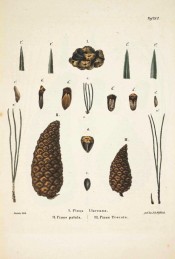Pinus cembroides Zucc. var. llaveana (Schiede) Voss
Frost-hardy, variable, evergreen tree with a dense, rounded head, silver-grey bark fissured red-brown, radially arranged, dark green leaves, to 6cm long, in twos or threes, and spherical green female cones, to 4cm across, ripening to brown. To 18m. There are several named varieties, one of which, edulis, has edible nuts. [RHSE, Hortus, Hilliers’].
Horticultural & Botanical History
Introduced to Britain in 1845. [JD]. ‘Pinus Llaveana Schiede. This species, now for some time in England, and which resisted the winter so well in 1837-8, although it looks more like a shrub than a tree in our gardens, is stated by the same author to form a tree 30 feet high, Schiede found whole woods of it between Zimapan and Real del Oro, and also cultivated occasionally in gardens. The seeds are sold in the markets of Mexico as pignons, and are said to be excellent. Professor Schlechtendahl states that the cone figured in Mr. Loudon’s Arboretum Britannicum, as belonging to this speces, is probably that of Pinus patula. The true cone is given in the Pinetum Woburnense.’ [BR misc.24/1839]. Leaves, female cones and seeds are figured in Die Coniferen. [Die Coniferen t.XV/1840-41].
History at Camden Park
Listed in the 1850 and 1857 catalogues [C.63/1850]. Pinus cembroides was included among desiderata in a letter to John Lindley dated 15th February 1848 but was not marked ‘arrived’ on Macarthur’s copy [MP A2933-1, p.157].
Notes
Pinus llaveana Torr. (1859) = Pinus parryana Voss
Published Jul 20, 2009 - 04:30 PM | Last updated Jul 29, 2010 - 03:28 PM

Pinus Pinus cembroides Zucc. var. llaveana (Schiede) Voss | Die Coniferen t.XV/1840-41 | BHL. Pinus llaveana is fig. i in the centre.
| Family | Pinaceae |
|---|---|
| Category | |
| Region of origin | Southern USA, Mexico |
| Synonyms |
|
| Common Name | Mexican pinon, Mexican stone pine, Mexican nut pine |
| Name in the Camden Park Record | Pinus Llaveana |
| Confidence level | high |

